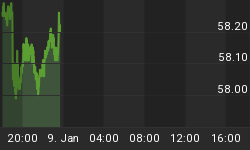As a result of active "demonetization" efforts by the IMF and its member central banks, gold and silver have experienced the type of volatility that has given conservative investors reasons not to perceive the metals as dependable cash alternatives. Instead gold and silver have become known as the asset class to hold as a hedge against inflation.
However, during the 1990's, when inflation was in general much higher than it has been since the turn of the millennium, gold and silver prices drifted lower and stagnated. However, since 2000, gold and silver have risen by over 400 and 700 percent respectively. Remarkably, this has occurred over a time frame during which, by most accounts, low inflation has prevailed. How can this be explained?
In 1944 when the U.S. dollar was considered 'as good as gold,' it was made the international reserve currency. This unique status is the reason that Fed Chairman Ben Bernanke was recently able to say that, "The U.S. Government has a technology, called the printing press that allows it to produce as many dollars at it wishes at essentially no cost."
Today, with the Federal Reserve treating the greenback as a never ending lottery ticket for deficit spending politicians, many investors feel the U.S. dollar is good for nothing. As a result there is an increasing international pressure to remove the U.S. dollar's reserve status. Given that there is no widely accepted alternative to the dollar (the euro has many problems of its own), this is creating fears of an international currency crisis, which has fueled interest in precious metals. So metal prices have risen even with low inflation expectations.
In order to paper over the effects of the financial collapse, central banks around the world are printing as fast as their presses can manage. But unlike prior periods of monetary inflation (like the 1970's), some major powers (China) are withdrawing liquidity. In addition, emerging market manufacturers are holding down prices even as currencies lose value. This may explain the strong performance of metals despite seemingly manageable inflation. But if higher prices emerge into the light of day (as they already have in commodities), currency uncertainty combined with high inflation should intensify the market for precious metals. The question then becomes how to play the market.
Gold has always been the reserve asset of choice for central banks and major private investors. But now, as smaller investors become aware that paper dollars are under threat, many are looking towards silver. Taken in aggregate, these smaller investors have enormous buying power. Through ETF's and mining stocks they are not bound by government restrictions on holding precious metals in retirement funds. In contrast to gold, central banks do not hold much silver. They are therefore less able to push down the price of silver by dumping inventory when rising metal prices undermine currency confidence.
Indeed, so far this year, silver is up nearly 50% while gold is up only about 6%. Given these figures, investors may be forgiven if they feel that the big move in silver may be over. Technical analysis may provide comfort.
According to the U.S. geological survey silver is about 17.5 times more abundant than gold in the earth's crust. This ratio has long been appreciated by civilizations throughout history. Thus, in 1792 the newly formed U.S. Congress passed the First Coinage Act, which legally set the valuation ratio of gold/silver at 15 (it was raised to 16 in 1834). In the early 1990's, with silver out of favor with investors, the ratio approached 100. At the beginning of this century gold stood at some $250 an ounce and silver at $4, putting the ratio at about 62. Today, with gold at around $1,500 an ounce and silver at $45, the ratio has closed to around 33. But this is still far higher than the ratio seen in the late 1980's (silver's last mega spike), and if far higher than the natural proportions of gold and silver would suggest.
The demand for physical silver also remains strong, which supports the market for spot silver. Smaller investors may find gold too expensive at $1,461 an ounce, but may be nevertheless prepared to buy several ounces of silver for much less. Potentially, this 'poor man's gold' market may help drive silver prices far faster than gold.
Subscribe to Euro Pacific's Weekly Digest: Receive all commentaries by Peter Schiff, Michael Pento, and John Browne delivered to your inbox every Monday.
Click here for free access to Euro Pacific's new special report: What's Ahead for Canadian Energy Trusts?
Be sure to pick up a copy of Peter Schiff's hit economic fable, How an Economy Grows and Why It Crashes.
















